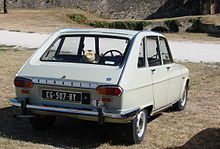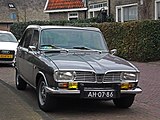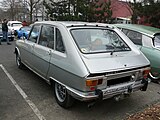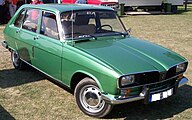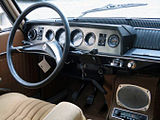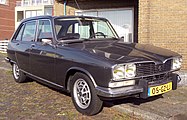Renault 16
| Renault | |
|---|---|
|
Renault 16 (1965-1970)
|
|
| 16 | |
| Production period: | 1965-1980 |
| Class : | Middle class |
| Body versions : | Station wagon |
| Engines: |
Petrol engines : 1.5-1.65 liters (40-68 kW) |
| Length: | 4240 mm |
| Width: | 1628 mm |
| Height: | 1450 mm |
| Wheelbase : | left: 2720 mm, right: 2650 mm |
| Empty weight : | 980-1060 kg |
| successor | Renault 20 |
The Renault 16 - R16 for short - is a mid-range vehicle from Renault . From January 1965 to January 1980 around 1,850,000 copies were built.
History of origin
In 1961, Pierre Dreyfus , the then head of Renault, gave the order to develop a new, family-friendly vehicle. Gaston Juchet then designed the R16 as a hatchback sedan .
From 2 December 1964, were pre-production vehicles manufactured in January 1965 began mass production in a newly built plant in Sandouville with Le Havre . At the end of 1965, the R16 was voted Car of the Year 1966.
Other locations for the assembly of the Renault 16 were Flins in France and Melbourne in Australia .
engine and gears
The R16, built exclusively as a five-door hatchback, is considered to be the first hatchback in the upper middle class, while the Autobianchi Primula that was previously on the market was somewhat smaller.
The engine of the R16, a gasoline engine of the Cléon-Alu or bloc A type , was the first from Renault whose block was made of an aluminum alloy . The liners are made of gray cast iron and are "wet", that is, they are surrounded by the cooling water. The chain-driven camshaft is located next to the cylinders in the crankcase and actuates the parallel hanging valves via tappets, push rods and rocker arms ("raised camshaft") mounted in the cylinder head. The engine is placed lengthways behind the front axle. The transmission , which is operated by a steering wheel shift, is located in front of the engine in the direction of travel. For a long time, this arrangement was typical of French automobile construction. At Renault it was found in the R16, in the R3 / R4 , R5 / R7 and R6 models , at Citroën from 1934 in the Citroën Traction Avant and later in the DS and the SM . Their advantage lies in the even weight distribution, as the heavy engine moves closer to the center of the vehicle and the vehicle's center of gravity is further back.
The design with front-engine , front-wheel drive and hatchback later became standard in the compact class, but found its way into the middle and upper middle classes from the 1970s onwards.
Engines
- Luxe / Super: 1565 cm³ with 40.5 kW / 55 PS (01 / 1965-06 / 1975)
- TL: 1470 cm³ with 40 kW / 54 PS (07/1975–01/1980)
- L / TL / TA: 1565 cm³ with 49 kW / 67 PS (01 / 1971–01 / 1980)
- TS: 1565 cm³ with 61 kW / 83 PS (09 / 1968–01 / 1980)
- TX: 1647 cm³ with 68 kW / 93 PS (06/1973–01/1980)
landing gear
The R 16 has different wheelbases on the left and right sides of the vehicle. As with the Renault 4 , Renault 5 and Renault 6 models , these resulted from the arrangement of the torsion bars , which are arranged next to one another on other vehicles, but one behind the other on Renaults. This meant that longer spring bars could be used and you didn't need a stable and heavy suspension in the middle of the car, but the bearings of the rear swing arms are slightly offset. The front wheels are suspended from double triangular wishbones and have torsion bars installed lengthways . The suspension is soft, it allows a relatively high speed even on larger bumps. The long suspension travel is made possible by the long torsion bars and the very long shock absorbers; the rear shock absorbers extended to the upper edge of the backrest.
inner space
The construction of the rear seat bench allows a great variability of the trunk . The bench can be removed in a few simple steps and without tools, so that up to 1600 liters of cargo can be stowed. Normally, the load volume with the rear bench seat installed is 346 liters. There are a total of seven options for arranging the rear bench: Among other things, the backrest of the rear bench seat can also be attached below the headliner and the seat can be folded forward.
The fact that the steering wheel gearshift was retained until the end of production was exceptional: the gearshift lever for both the manual and automatic transmissions protruded from the right-hand side of the steering column. This and the handbrake in the driver's footwell create space for a spacious compartment and armrest between the front seats. Some model variants are also equipped with electric central locking and electric window regulators in the front doors.
Facelift
The Renault 16 was revised for the first time in October 1970. All models received larger taillights . From autumn 1973 the R16 was offered in a TX variant with 93 hp, which differed from the other model versions with its double headlights and the standard rear window wiper.
In September 1974 the R16 was modified again. Now the aluminum grill gave way to one made of black plastic. Only that of the R16 TX still had chrome-plated lamella edges to set itself apart from the other lines as a top model.
Engine variants
| Furnishing | power | Displacement | Top speed | Max. Torque |
|---|---|---|---|---|
| R16 Luxe, super | 54/55 hp | 1470 cc | 140 km / h | 105 Nm at 2800 min -1 . |
| R16 L, TL, TA | 67 hp | 1565 cc | 148 km / h | 127 Nm at 3000 min -1 |
| R16 TS | 83 hp | 1565 cc | 165 km / h | 120 Nm at 3500 min -1 |
| R16 TX | 93 hp | 1647 cc | 170 km / h | 129 Nm at 4000 min -1 |
The engine was also used in the Lotus Europa , the Renault Alpine and their racing versions with an output of up to 126 kW (172 hp).
reception
One still frequently in the media-to-find and at the time of the Renault advertising apprehended incident, according to the former British expressed Formula 1 - racing driver Sir Stirling Moss as follows on the R16:
"There is no doubt that the Renault 16 is the most intelligently engineered automobile I have ever encountered and I think that each British motorcar manufacturer would do well to purchase one just to see how it is put together."
"Without a doubt, the Renault 16 is the most intelligently designed automobile I have ever come across and any British automaker would do well to buy one just to see how it's built."
Web links
- René's Renault Pages (en)
- Magnus Bjelk from Sweden (en)
- Report at Spiegel Online
- Website of an Austrian Renault 16 fan
Individual evidence
- ↑ Auto, Motor und Sport , Issue 13/1968, p. 56, found on May 19, 2008: club-renault16.de (PDF)
- ^ Spiegel Online , accessed on August 12, 2012.
- ↑ Page3.ch , accessed on August 12, 2012.
- ↑ Kabel1.de , accessed on August 12, 2012.
- ↑ Popular Mechanics , June 1970 edition, p. 193.
- ↑ books.google.de , p. 19.
- ↑ books.google.de , p. 5.

